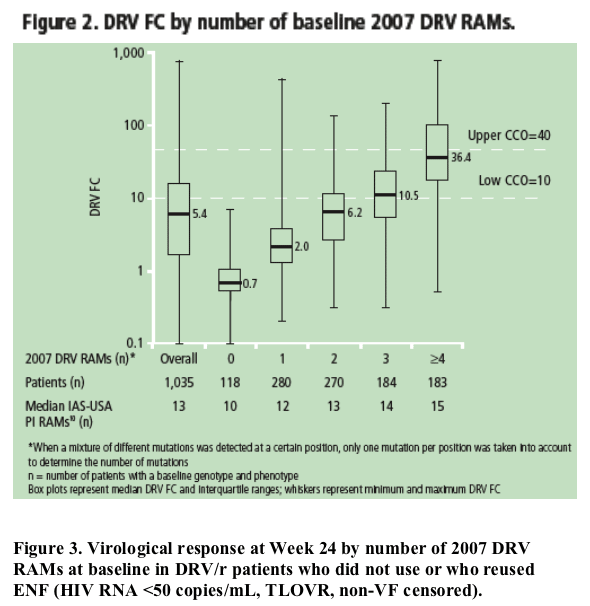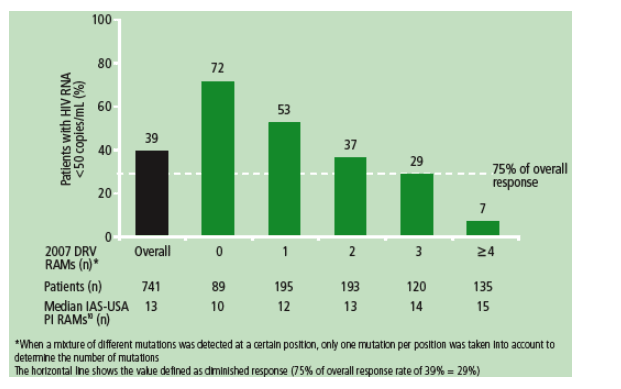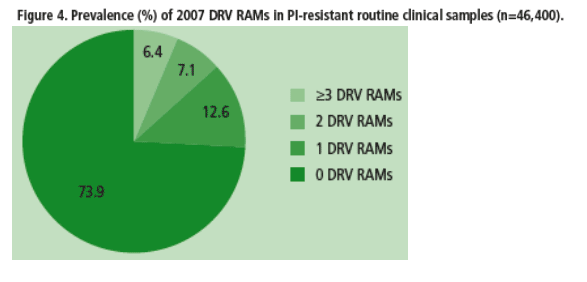 |
 |
 |
| |
Slightly Revised Darunavir Resistance Profile from Tibotec
|
| |
| |
Phenotypic and genotypic determinants of resistance to darunavir: analysis of data from treatment-experienced patients in POWER 1, 2, 3 and DUET-1 and DUET-2
Reported by Jules Levin
XVII HIV Drug Resistance Workshop
June 10-14, 2008
Sitges, Spain
Sandra De Meyer,1 Inge Dierynck,1 Erkki Lathouwers,1 Ben Van Baelen,1 Tony Vangeneugden,1 Sabrina Spinosa-Guzman,1 Monika Peeters,1 Gaston Picchio,2 Marie-Pierre de Bethune1
1Tibotec BVBA, Mechelen, Belgium; 2Tibotec Inc., Yardley, PA, USA
AUTHOR CONCLUSIONS
· This larger clinical dataset from the POWER and DUET trials enabled new analyses to study phenotypic and genotypic determinants of resistance to DRV.
· The previous determined CCOs of 10 and 40 were confirmed in this analysis.
· Analyses assessing the influence of baseline mutations on virological response and in-vitro susceptibility to DRV, and the development of mutations in patients experiencing VF, resulted in the following 2007 DRV RAMs:
V11I, V32I, L33F, I47V, I50V, I54L/M, T74P, L76V, I84V and L89V
- 10 out of the 11 2007 DRV RAMs have been previously identified4
- one new DRV RAM, T74P was identified.
· The presence of >/=3 2007 DRV RAMs was associated with a median DRV FC >10 and a diminished virological response.
· While the numbers of DRV RAMs from the 2006 and 2007 lists were both predictive of virological response, a slightly better prediction was observed with the 2007 list.
· The prevalence of 2007 DRV RAMs was low in PI-resistant routine clinical samples.
Introduction
· The efficacy and tolerability of the protease inhibitor (PI) darunavir with low-dose ritonavir (DRV/r) has been demonstrated in clinical trials of treatment experienced, HIV-1-infected patients.1-3
· Pooled resistance data from the Phase IIb randomised, controlled POWER 1 and 2 studies (TMC114-C213 and TMC114-C202) and the open-label POWER 3 analysis (TMC114-C215 and TMC114-C208) in treatment-experienced patients who initiated treatment with DRV/r 600/100mg twice daily (bid) (n=458) led to the determination of
- two DRV clinical cut-offs (CCOs), of 10 and 404
- a diminished response to DRV/r when at least three of 11 DRV resistance-associated mutations (DRV RAMs 2006: V11I, V32I, L33F, I47V, I50V, I54L/M, G73S, L76V, I84V and L89V) were present at baseline.4
· The DUET-1 and DUET-2 trials (TMC125-C206 and TMC125-C216) are two ongoing randomised, placebo-controlled, double-blinded, Phase III trials investigating the efficacy and safety of the NNRTI etravirine (ETR; TMC125), as part of a regimen including DRV/r, investigator-selected NRTIs and optional enfuvirtide (ENF) in highly treatment-experienced patients.5,6
· Given that the patients in the POWER trials who initiated treatment with DRV/r 600/100mg bid and the patients in the placebo groups of the DUET trials who received DRV/r 600/100mg bid without ETR were similar, the data were pooled to increase the strength of the resistance analyses.
· This larger dataset was used
- to reassess DRV CCOs
-- to identify new DRV RAMs and update the current list (DRV RAMs 2006) to create the 2007 DRV RAMs list.
Methods
· All patients included in the Week 96 analysis of the POWER trials and the primary Week 24 analysis of the DUET trials (placebo group) were included in this analysis.5-7
· Genotypes and phenotypes of plasma viruses were determined using population-based sequencing and Antivirogram, respectively (Virco BVBA, Mechelen, Belgium).
Determination of DRV CCOs
· The analysis was performed on data from the placebo groups of DUET-1 and DUET-2.
· Linear modelling analysis of covariance (ANCOVA) was performed to assess the relationship between baseline DRV fold-change in 50% effective concentration (FC) and the Week 24 virological response (change in log10 viral load [VL], non-completer=failure [NC=F]). Baseline DRV FC, use of ENF (did not use/reused), number of susceptible NRTIs in the optimised background regimen, baseline CD4+ cell count and baseline VL were covariates. CCOs were defined using this model, specifically for the subgroup of patients who did not use/reused ENF excluding patients who discontinued due to other reasons than virologic failure (VF) (n=404). Inverse prediction was applied to estimate which FCs corroborate with the 95% confidence limits of a predicted decrease of 1 log10 VL versus baseline.
Identification of mutations predictive of a diminished response8
· The analysis of the influence of protease mutations on in-vitro susceptibility to DRV was performed using the screening and baseline genotype and phenotype data from the POWER 1, 2 and 3 and DUET-1 and DUET-2 trials (n>2,500).v
· The analyses of the influence of baseline protease mutations on virological response, and the development of protease mutations were performed on pooled data from 1,071 patients who initiated treatment with DRV/r 600/100mg bid in POWER 1, 2 and 3 (n=467) and from the placebo groups of DUET-1 and DUET-2 (n=604). Week 24 data were used to study the association between baseline protease mutations and virological response, while all timepoints were used to study the development of mutations.
· The analysis of the development of mutations was performed in patients who experienced VF by rebound, i.e. patients who lost a previously gained VL decrease 31.0 log10 below baseline.
· Analyses of virological response and identification of VFs were performed using a time-to-loss of virological response (TLOVR) non-VF censored analysis.
· DRV RAMs were defined as protease mutations that fulfilled at least two of the following three criteria
1. protease mutations associated with an increased DRV FC using a stepwise regression model (only protease mutations present in >50 isolates were taken into account)
2. baseline protease mutations present in at least 37 (5%) patients (in the group who did not use or who reused ENF) that were associated with a diminished virological response (<75% of the overall response [HIV RNA <50 copies/mL] i.e. 75% of 39% = 29%) at Week 24
3. protease mutations developing in 310% of VFs by rebound, as defined above.
· An analysis of variance (ANOVA) model including the covariates baseline VL, baseline CD4+ cell count, number of susceptible NRTIs in the background regimen, ENF use (na´ve, did not use/reused), and number of DRV RAMs (2006 or 2007 list) was performed to determine whether the number of DRV RAMs was a significant predictor of response.
Prevalence of 2007 DRV RAMs
· The prevalence of 2007 DRV RAMs was studied in 98,326 routine clinical samples submitted to Virco between November 2004 and November 2007.9 Of these samples, 46,400 were PI-resistant with resistance defined as any change at amino acid positions 30, 32, 36, 46, 47, 48, 50, 53, 54, 73, 82, 84, 88, or 90 (US FDA mutations list).
Results
Determination of DRV CCOs
The estimated mean change in log10 VL (NC=F) at Week 24 compared with baseline and the 95% confidence limits as a function of the baseline DRV FC are shown in Figure 1. Applying inverse prediction to the 95% boundaries of the regression line revealed a low CCO of 10.6 and an upper CCO of 36.6. This analysis on the placebo groups of the DUET trials confirmed the DRV CCOs 10 and 40 that were previously identified based on the POWER trials.4

Identification of mutations predictive of a diminished response: 2007 DRV RAMs
Influence of type of protease mutations on DRV in-vitro susceptibility (criterion 1)
The effect of the presence or absence of protease mutations on DRV FC was tested using a univariate model. Based on this model, 26 mutations were estimated to lead to an increase in DRV FC of at least two-fold, all with a significance level of <0.05. A stepwise regression model conducted thereafter yielded 15 protease mutations associated with a >1.5-fold increase in DRV FC: L10F, V11I, V11L, V32I, L33F, I47V, I50V, I54L, I54M, G73C, T74P, L76V, V82I, I84V and L89V.
Influence of type of baseline protease mutations on virological response (criterion 2)
Baseline protease mutations associated with a diminished virological response (<75% of the overall response [HIV RNA <50 copies/mL] i.e. 75% of 39% = 29%) at Week 24 were identified in DRV/r-treated patients who either did not use or who reused ENF. The presence of the protease mutations V11I, G16A, K20V, V32I, E35N, I47V, I50V, I54L, I54M, I66V, T74P, L76V, I84V and/or L89V at baseline were associated with a diminished virological response at Week 24.
Development of protease mutations in VFs by rebound (criterion 3)
Of the 1,071 patients studied, 18% (n=188) met the rebounder definition. Baseline and endpoint genotypes were available for 185/188 rebounders. Protease mutations that developed in >/=10% of the analysed rebounders were V11I, I13V, V32I, L33F, I50V, F53L, I54L and L89V.
Compilation of the 2007 DRV RAMs list
· Eleven protease mutations met at least two of the three predefined criteria and thus were included in the 2007 DRV RAMs list V11I, V32I, L33F, I47V, I50V, I54L/M, T74P, L76V, I84V and L89V (Table 1). The only differences between the 2006 and 2007 DRV RAMs lists are the exclusion of G73S and the addition of the T74P protease mutation.
· Each of the 11 DRV RAMs in the 2007 list was present with a median of 13-15 IAS USA PI RAMs10 at baseline.

Influence of number of baseline 2007 DRV RAMs on DRV in-vitro susceptibility and on virological response
· The median DRV FC increased with increasing numbers of 2007 DRV RAMs. A median DRV FC >10 (low CCO) was found with >/=3 of the 2007 DRV RAMs (Figure 2).
· In patients who did not use or who reused ENF, the virological response rate decreased with increasing numbers of baseline 2007 DRV RAMs. A diminished virological response at Week 24 was observed in this group for patients with >/=3 2007 DRV RAMs at baseline (Figure 3). This result is consistent with previous analyses.4
· An ANOVA model showed that the number of DRV RAMs in both the 2006 and 2007 lists were significant predictors of response (change in VL, NC=F non-VF censored; p<0.001), and that the number of DRV RAMs in the 2007 list was slightly more predictive of response than the 2006 list (higher F-value i.e. 69.83 vs 57.17).


Prevalence of 2007 DRV RAMs
Among routine clinical samples with evidence of PI resistance, 93.6% harboured <3 2007 DRV RAMs and 73.9% harboured no 2007 DRV RAMs (Figure 4).9

References
1. Clotet B, et al. Lancet 2007;369:1169-78.
2. Molina JM, et al. JAIDS 2007;46:24-31.
3. Madruga JV, et al. Lancet 2007;370:49-58.
4. De Meyer S, et al. AIDS Res Hum Retroviruses 2008;24:379-88.
5. Madruga JV, et al. Lancet 2007;370:29-38.
6. Lazzarin A, et al. Lancet 2007;370:39-48.
7. Pozniak A, et al. 11th European AIDS Conference, Madrid, Spain, 24-27 October 2007. Abstract P7.2/07.
8. De Meyer S, et al. 6th European HIV Drug Resistance Workshop, Budapest, Hungary, 26-28 March 2008. Abstract 54.
9. Lathouwers E, et al. 6th European HIV Drug Resistance Workshop, Budapest, Hungary, 26-28 March 2008. Abstract 68.
10. Johnson VA, et al. Top HIV Med 2006;14:125-130.
|
| |
|
 |
 |
|
|